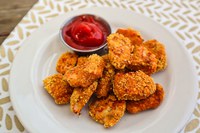Prairie Fare: Be thrifty in your food purchases
(Click an image below to view a high-resolution image that can be downloaded)
By Julie Garden-Robinson, food and nutrition specialist
NDSU Extension
We took our younger daughter out for celebratory dinner at a somewhat “fancy” restaurant. She had been selected for an internship and also had a second part-time job.
We typically go to this restaurant for birthdays or other special occasions. Usually, a line extended out the door on Friday nights.
On this particular night, we were seated immediately. In fact, the manager seemed very happy we chose this restaurant. He asked us if we were there for a special occasion.
The next day we went shopping for some items for her first apartment as she continues her college years in the fall.
I like to rescue furniture by repainting or refinishing wooden pieces. Along with saving money, I get some personal satisfaction in making old things new again. I learned these lessons from my youth.
The parking lots to the thrift stores had many cars, and the stores were brimming with people. My husband commented on the high-end vehicles in the parking lot. He would notice things like that.
I found this to be an interesting commentary on the current economy. Consumers are increasingly conscious about how they are spending the money. “Thrifting” supports the local community and prevents items from going to a landfill.
According to an online “Resale” report, 80% of consumers are OK with buying secondhand, which is a significant increase in the last few years. From clothing to furniture, thrifting is particularly popular among the high school and college-age crowd.
Being thrifty is a good thing in that money and other resources are used carefully and not wastefully.
In fact, the U.S. Department of Agriculture “thrifty food plan” made its debut in 1975 and replaced the 1962 Economy Food Plan.
With the current rising costs of food and fuel, using our resources wisely is a good thing. The USDA currently provides official nutritious cost of food at home at three levels: low-cost, moderate-cost and liberal plans for children through adults ages 71 and up.
For example, a 51-year-old male would expect to spend $61.20 weekly on food at home for a low-cost plan, $77 weekly for a moderate-cost plan and $92.30 weekly for a liberal plan.
The thrifty food plan at www.fns.usda.gov/snap/thriftyfoodplan aligns with current nutrition recommendations, represents a limited food budget, reflects what people buy and eat, and supports a healthy lifestyle.
These are some of the tips provided from USDA to help us stay on our budget.
- When your food budget allows, buy extra low-cost, nutritious foods such as potatoes and frozen orange juice concentrate. These foods keep well.
- Compare the cost of convenience foods with the same foods made from scratch. “Convenience foods” are products such as fancy baked goods, frozen meals, and vegetables with seasonings and sauces. Most of these cost more than similar foods prepared at home.
- Try store brands. They usually cost less than name brands, but they taste as good and generally have the same nutritional value.
- Take time to compare fresh, frozen and canned foods to see which is least expensive. Buy what’s on special and what’s in season.
- Prevent food waste. Buy only the amount that your family will eat before the food spoils.
Staying on a food budget requires planning, and NDSU Extension has many resources to help you, including “Pinchin’ Pennies in the Kitchen” and the “What’s Cookin’?” series. Search online for "NDSU Extension Food Preparation" for these topics plus many more.
Often you can prepare restaurant-like foods at home that are more nutritious and often more economical. Here is a recipe for baked chicken nuggets.
Baked Chicken Nuggets
1.5 pounds boneless, skinless chicken breast*
1 cup cornflakes or other ready-to-eat cereal crumbs
1 teaspoon paprika
½ teaspoon Italian herb seasoning or seasoning of your choice
¼ teaspoon garlic powder
¼ teaspoon onion powder
Dips such as honey mustard sauce, barbecue sauce or ketchup (optional)
Preheat oven to 400 F. Cut the chicken into bite sized pieces. Place cereal in a plastic bag and crush using a rolling pin or can. Add remaining ingredients to cereal crumbs. Close bag tightly and shake until blended. Add a few chicken pieces at a time to crumb mixture and shake to coat evenly. Discard any unused crumb mixture. Place chicken pieces on greased baking sheet so they are not touching. Bake until golden brown with an internal temperature of 165 F or about 12 to 14 minutes.
*You can substitute chicken thighs, but you will need to remove the skin and bones.
Makes four servings. Without dipping sauce, each serving has 230 calories, 4.5 grams (g) fat, 39 g protein, 6 g carbohydrate, 0 g fiber and 130 milligrams sodium.
(Julie Garden-Robinson, Ph.D., R.D., L.R.D., is a North Dakota State University Extension food and nutrition specialist and professor in the Department of Health, Nutrition and Exercise Sciences. Follow her on Twitter @jgardenrobinson)
NDSU Agriculture Communication – June 16, 2022
Source: Julie Garden-Robinson, 701-231-7187, julie.garden-robinson@ndsu.edu
Editor: Elizabeth Cronin, 701-231-5391, elizabeth.cronin@ndsu.edu




